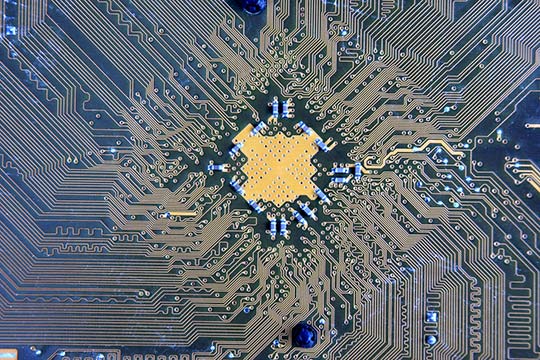TECHNOLOGY FOCUS
Larger and faster Systems-on-Chips employ multiple clock domains on the same die for several reasons:
Communications with external real-time or pre-defined clocks require chips to incorporate multiple, unrelated clock frequencies; it is more economical in very large chips to break down the system into independently clocked domains, saving some of the power required for clock distribution; and dynamic scaling of voltage and frequency creates multiple clock/voltage domains.
Interfaces among different clock domains are problematic and are only partly supported by commercial EDA tools.
As a result, synchronizationproblems are sometimes discovered only in working silicon, and even then they are hard and expensive to correct.


COURSE CONTENT
The course teaches the science, engineering and art of synchronization.
We define the problems, survey existing solutions, study the best designs, and learn how to select the better synchronizer for each
purpose.
We review clocking in digital chips, study the required theoretical basics, learn how to understand synchronization problems, identify them, create reliable solutions, and verify their correctness.
We consider SoC/ASIC and FPGA, mostly at the logical level. Implications on physical design are briefly reviewed. We also review voltage domains, power gating, voltage scaling and their effect on clock domains and synchronization.
WHO SHOULD ATTEND
This course is suitable for:
- VLSI/ASIC/SoC/FPGA design engineers,
- architects and managers engaged in the design of advanced SoC VLSI/ASIC/SoC/FPGA
- CAD engineers and developers
- Academic researchers, university professors, and graduate students interested in advanced SoC design
Basic knowledge of digital VLSI/ASIC/FPGA design is assumed. Prior exposure to issues and pitfalls of synchronization is an advantage, but neither
such exposure nor prior knowledge of synchronization is necessary. General background in electrical or computer engineering is useful.

Clock Distribution Networks
- Problem Definition
- What’s Ahead: The technology roadmap
- ASIC/SoC vs. Full-Custom Design Methodologies
- Standard Clock Trees for SoCs and FPGA
- Min-Delay and Max-Delay Problems
- Data Delay Insertion and Delay Line Circuits
- Clock Delay Insertion and Clock Tuning
- Unbalanced Tunable Clock Distribution Networks
- High Performance Clock Trees
- Passive and Active Deskew in Clock Trees
- Local Clock Generation with Tunable Frequencies
Metastability and Synchronization Failures
- Metastability
- Latches and Flip-Flops
- Measuring Metastability
- Probability and MTBF
- Synchronizer Circuits
- Symmetric Booster Synchronizer
- Latency and Settling Time
- Simulating Metastability
Synchronization of Asynchronous Clock Domains
- Control Synchronizers
- Formal Specification Using STG
- Data Validity of Synchronizers
- Push Synchronizers
- Timing Assumptions
- Faster Synchronizers
- Shared Latch Synchronizers
- FIFO Synchronizers
- Reset Synchronization
- Clock Gating and Selection Synchronizers
- Scan Insertion Synchronizer
- Mutual Exclusion and Arbiter
Common Synchronization Errors
- Avoiding Synchronization
- One flop Synchronizers
- Sneaky and Greedy Paths
- Half Protocol
- Async Clear
- Pulse Synchronizers
- Slow-to-Fast Synchronizers
- Metastability Blocker and Filters
- Parallel, Shared Latch, and Conservative
- Synchronizers
- Patented Circuits for Fast Resolution and Pre-Sampling Shaker and Dual Shaker Synchronizers
Verification of Synchronizers
- Identifying Domain Crossings
- Structural Verification
- Sorting the Domain Crossings
- Grouping Synchronizers
- Connecting Bi-Directional Protocols
- Recognizing Synchronizers
- Employing Formal Tools
- Functional Verification
- Data Verification
- Manual Verification
Multi-Synchronous and Periodic Synchronizers
- Mesochronous/Multi-SyncSynchronization
- Delay Variations
- Data Delay Synchronizers
- Conflict Detection
- Clock Delay Synchronizers
- FIFO Synchronizers
- Clock Edge Synchronizers
- Periodic Domains and Predictive Synchronizers
Multi-Synchronous and Asynchronous Long Interconnect
- Definition of Long Interconnects
- Point-to-Point, Buses and Networks on Chip
- Source-Synchronous and Adaptive-Clocked Interconnect
- Data Encoding: Dual rail and 1-of-4
- Four- and Two-Phase Protocols
- Asynchronous Interconnect
- Dual Rail and 1-of-4 Interconnect
- Two-Phase Dual Rail Interconnect
- Fast Serial Interconnect
- Asynchronous and MixedTiming FIFO
- Pipeline Synchronizers
- LDL Synchronizer
Multi-Clock Domain and GALS SoC
- Synchronizer-Based GALS
- Arbitrated and Handshake Stoppable Clocks
- Wrappers and Asynchronous Ports
- GALS Methodologies
- Desynchronization
- Synchronization in Networks on Chips (NoC)
Multiple Voltage Domains
- Definitions, Sources of Multiple Voltages
- Level Shifting and Isolating Gates
- Combining Voltage and Clock Domains
- Floor-Plan and Layout Constraint
Dynamic Voltage and Frequency Scaling
- DVS versus DVFS
- Global versus Multi-Domain Scaling
- Methods of DVFS

